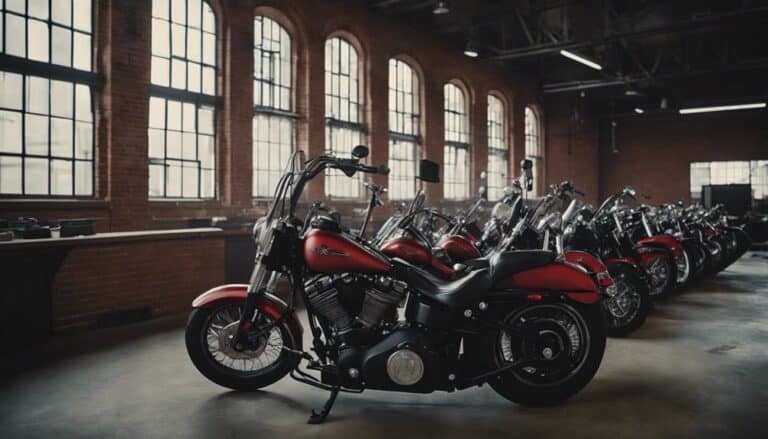Did you know that when it comes to Harley Davidson motorcycles, where they are built plays a significant role in the company's identity and market positioning?
The manufacturing locations and the balance between global production and maintaining a 'Made in America' label are crucial aspects to consider.
By understanding the intricacies of these factors, you can gain insight into how Harley Davidson navigates the complexities of the modern motorcycle industry.
Key Takeaways
- Harley Davidson motorcycles are primarily built in plants in Wisconsin and Pennsylvania in the US for assembly and manufacturing respectively.
- The company strategically sources parts from various countries like Taiwan, Japan, Italy, Germany, and Mexico to ensure quality.
- Efforts to retain a 'Made in America' label for the US market while addressing rising import costs through a plant in Thailand.
- Future plans include potential production shifts to balance cost efficiency and quality amidst evolving global trade dynamics.
Ownership and Founding History
Harley Davidson was established in 1901 by William Harley and Arthur Davidson, evolving from a motorized bicycle project to become a prominent manufacturer of motorcycles. One significant aspect of Harley Davidson's history is its involvement with the United States Military. During World War I, the company became a crucial supplier of motorcycles to the military, showcasing the reliability and strength of their bikes in demanding conditions. This partnership not only boosted Harley Davidson's reputation but also solidified their position as a trusted manufacturer of quality motorcycles.
Additionally, Harley Davidson experienced shifts in ownership over the years. One notable change was when the company was acquired by American Machine and Foundry (AMF). This acquisition led to a period of restructuring and adjustments within the company. Despite the changes in ownership, Harley Davidson's commitment to producing top-notch motorcycles remained unwavering, showcasing their resilience and dedication to their craft. Arthur Davidson's legacy and vision continued to inspire innovation and excellence within the company, shaping its path for years to come.
Manufacturing Locations Overview
With manufacturing plants located in Wisconsin and Pennsylvania in the US, Harley Davidson strategically positions its production facilities to cater to different aspects of its motorcycle manufacturing process. The Wisconsin facility, based in Milwaukee, serves as the company's headquarters and focuses on the assembly of various Harley Davidson models. On the other hand, the Pennsylvania plant in York specializes in producing powertrains, frames, and fenders. This division of labor allows for a streamlined production process and efficient allocation of resources. The table below provides a glimpse into the distribution of manufacturing tasks across these two key locations:
| Manufacturing Location | Facility | Specialization |
|---|---|---|
| Wisconsin | Milwaukee | Assembly of Harley Davidson models |
| Pennsylvania | York | Production of powertrains, frames, and fenders |
Impact of Global Production
To understand the implications of Harley Davidson's global production strategies, it's crucial to examine how the company's manufacturing footprint has evolved over time. While Harley Davidson motorcycles are primarily assembled in the US to cater to American customers and maintain a focus on domestic production, the company has strategically diversified its sourcing of parts from countries such as Taiwan, Japan, Italy, Germany, and Mexico.
The establishment of a plant in Thailand was a response to rising import costs to Europe, demonstrating Harley Davidson's adaptive production shifts in the global market.
Efforts have been made to retain a 'Made in America' label for the US market, with different models incorporating varying numbers of American-made parts. The closure of the Kansas City plant in 2019 and the subsequent establishment of production facilities in different countries underline Harley Davidson's dynamic approach to addressing challenges in global production.
Quality Assurance Processes
Implementing stringent quality assurance processes is essential for ensuring the high standards maintained in Harley Davidson motorcycles' production. Harley Davidson integrates quality control measures at various stages of manufacturing to uphold consistency and reliability.
Stringent testing procedures are followed for critical components such as engines, frames, and electronics to meet stringent safety and performance requirements. Trained professionals conduct inspections to identify and rectify any defects or issues in the manufacturing process, ensuring a top-quality product.
Continuous improvement initiatives are also in place to enhance quality standards and customer satisfaction in Harley Davidson motorcycles. By adhering to these rigorous quality assurance processes, Harley Davidson can deliver motorcycles that not only meet but exceed customer expectations, solidifying its reputation for producing high-performance and reliable bikes.
These practices underscore Harley Davidson's commitment to excellence and continuous improvement in its manufacturing processes.
Future Expansion Plans
Considering market dynamics and global competitiveness, future expansion plans for Harley-Davidson involve a strategic balance of cost efficiency and product quality while adapting to evolving trade environments. With production facilities in Wisconsin, Harley-Davidson aims to navigate the global market by potentially shifting some production to mitigate EU tariffs while ensuring profits still benefit the U.S.
The company prioritizes staying competitive over fixating on production locations, aligning with other industry players like Polaris who are also contemplating production shifts based on market dynamics. In the face of changing trade landscapes, companies may opt to move production overseas to sustain their edge in the global market.
Harley-Davidson's future production strategies seek to harmonize costs and quality, demonstrating a proactive approach to meeting the demands of an ever-evolving global trade arena. As the market continues to shift, companies like Harley-Davidson must remain agile and strategic in their expansion plans to secure their positions in the competitive motorcycle industry.
Conclusion
You now know that Harley Davidson motorcycles are built in the United States, with assembly taking place in Wisconsin and Pennsylvania. Despite sourcing parts from various countries, the company strives to maintain a 'Made in America' label.
Did you know that over 90% of all Harley Davidson motorcycles sold worldwide are still manufactured in the US? This statistic speaks to the company's commitment to American craftsmanship and tradition.

